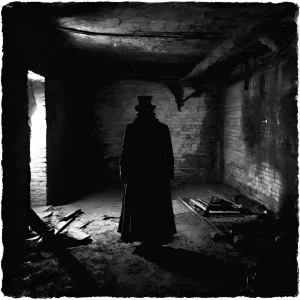12 Gay Street

12 Gay Street
Beautiful townhouse, once a “Pirate’s Den” speakeasy, is among Greenwich’s most haunted buildings.
Welcome to New York City’s iconic Gay Street, a short, twisted Manhattan road west of 6th Avenue. The street has appeared in countless films, including 1943’s A Night to Remember, and several music videos, such as Sheryl Crow’s “A Change Would Do You Good. But why New York Ghosts has included it on its chilling tour of Greenwich Village is because Gay Street abounds with history and lingering paranormal activity.
“A huge misnomer hangs over the origin of the name of Gay Street.”1 Its beginnings have nothing to do with the city’s LGBT culture. In fact, started out as an alley of stables and was most likely named after an early wealthy landowner. Wealthy New Yorkers who lived in Waverly Place when Washington Square opened in 1826 would keep their horses there. During the same era, a morgue was located in this area. Many believe the morgue’s dead continue to haunt the neighborhood. Many tattered corpses of men and women have been seen slowly shuffling through the streets, before vanishing around a corner, in mid-air, or through a building.
After Gay Street was widened and became an official “street” in 1833, Federal houses began popping up along its west side. Construction of residential buildings slowed when “a financial crisis”2 known as the Panic of 1837 stressed the nation’s commercial activities. The economy would take some ten years to rebound, and Gay Street began to slowly be populated. Post-recession, most of its residents were of African-American descent, “many of them servants of the wealthy white families on Washington Square.”3
Gay Street soon established itself as a place that celebrated the bohemian revolution. Speakeasies, taverns, theaters, music venues – such businesses flourished there. The most famous one is known as the Pirate’s Den. The Pirate’s Den, located at 12 Gay Street, was built in 1827. The building first housed black servants of rich Dutch colonists who lived in their larger homes in the central parts of Manhattan. Later, 12 Gay Street became the home of several prominent New Yorkers, including Depression-era NYC Mayor Jimmy Walker, Howdy Doody puppeteer Frank Paris, and the pulp-fiction novelist Walter Gibson.
“With its secretive, arched appearance and deceivingly quiet demeanor,”4 Gay Street soon became the natural choice for underground drinking establishments during the prohibition era. In the 1920s, the corrupt New York City Mayor, Jimmy Walker, purchased the building at 12 Gay Street to run a speakeasy he called the “Pirates Den”. Mayor Walker also thought of this tucked-away location to be the perfect place to secretly board his mistress, Broadway actress Betty Compton.
Imagine underground parties thrown by the city’s Mayor himself. Night after night, this building hosted lavish parties filled with drinking, dancing, and decadence. Even though the music and laughter has departed, some people still hear the clicking of flapper heels on the basement floor. It’s as if at the Pirate’s Den, the party continues. Others report seeing the spectral figures of females decked in full 1920s attire, complete with feathered headbands. Another apparition walks the basement wearing a black suit with tails, perhaps another former patron of the Walker’s notorious Pirate’s Den.
A medium was invited to the building to investigate its haunted past. During her visit, she sensed a distraught man accused of hiding a secret. He claimed to have been interrogated and tortured to death at the Pirate’s Den. Since so many powerful men frequented the speakeasy, who knows what may have happened within its walls? Disputes over money, drunken arguments, fights over women? Or perhaps many of these lingering ghosts are simply victims of the playboy mayor’s displeasure and were murdered by his cronies.
During the 1950s and 60s, acclaimed puppeteer Frank Parris moved his family into 12 Gay Street. Parris was known as a pioneer in puppetry and had performed at Madison Square Garden, Radio City Music Hall, as well as many night clubs. So when popular radio host Buffalo Bob Smith got the idea for a Western-themed, “puppet-and-people program”5 for kids in 1947, he knew just who to ask to create the show’s star. Howdy Doody was thus soon born in the basement of 12 Gay Street.
While the Parris family resided at there, they too could detect the presence of lingering spirits in the building. According to Mr. Parris, he would often hear disembodied footsteps climbing the stairs, or the sounds of moving objects. The family dog must have also picked up strange noises as well, ones which human ears could not detect. It would bark ferociously at dark corners of the home, for instance, as if to warn off some invisible intruder. In life, the dog fended off the house’s spirits; in death, it joined them. After their beloved pet’s passing, family members claimed to sometimes still feel it brush up against their legs. Perhaps it wanted to continue protecting them.
Mr. Parris “also reported the smell of violets and of frying onions when no one else was in the house.”6 He would thus eventually bring “six different mediums to the bedeviled house in his efforts to solve the puzzle of the mystifying phantoms, noises, and odors.”7
The Parris clan had one particularly chilling paranormal encounter while hosting guests at their home. Downstairs, everyone was enjoying the evening until the sound of loud pounding from upstairs abruptly halted conversations. As the unexplainable noise continued to increase, the guests exchanged nervous glances. They then asked Mr. Parris if someone lived upstairs. After a long pause, he responded, “No one… Not a living a soul.”
Another guest visiting the Parris family recalled a similarly disturbing visit to the home. While walking through the house, she paused to look up at the doorway leading to the hall and stairs. She claimed to have seen a man with dark hair dressed in full evening clothes, complete with a top hat and opera cape. She quickly turned to get Mr. Parris’s attention, but before she could point out the strange man, he had disappeared “like a puff of smoke.” Locals also often spot the hazy apparition of this man wandering aimlessly along the sidewalk, perhaps unaware of his death and trying to find his way home. They call him the Phantom of Gay Street.
Writer and stage magician Walter Gibson would like to think that he is the “creator” of this spirit. “Since I was living in The Village, I laid the plot [of The Shadow] there, and I visualized Cranston moving through the hallways of the house as I wrote. I visualized the character so strongly that his image was impressed on the surroundings.”8 Lamont Cranston was the main character of Gibson’s pulp series, The Shadow Magazine. His alter ego, “The Shadow”, was “a crime-fighting vigilante with psychic powers posing as a “wealthy, young man about town.”9 Some believe that Cranston has left the pages of Gibson’s work and manifested itself as a real ghost on Gay Street!
Indeed, since the 1920s, almost every person who lived at 12 Gay Street experienced something paranormal. This included seeing spooky shadows moving up and down the stairwell and hearing disembodied footsteps throughout the halls. When another psychic investigated the building, she overheard the heated and ghostly argument between a woman and a Chinese man named Ming. Who knows what other lingering spirits continue to haunt this former speakeasy? “‘I wouldn’t go in there right now — it’s legendary that ghosts live there,’ said neighbor Randy Credico, who’s lived across the street for twenty years. ‘That place would be like moving into The Shining.’”10
Today, the four bedroom apartment at 12 Gay Street serves as a private residence. Given the building’s haunted history, surely the family inside has gotten a few unexpected visitors!
Works Cited
- Bowery Boys. “MISTRESSES AND MISNOMERS: THE STORY OF GAY STREET.” Boweryboyshistory.com. 25 June 2009. Web. 1 November 2015. Para. 2.
- “Panic of 1837.” Wikipedia.org. Last modified 19 October 2015. Web. 2 November 2015. Para. 1.
- “Gay Street (Manhattan).” Wikipedia.org. Last modified 23 June 2015. Web. 2 November 2015. Para. 3.
- Bowery Boys. “MISTRESSES AND MISNOMERS: THE STORY OF GAY STREET.” Boweryboyshistory.com. 25 June 2009. Web. 1 November 2015. Para. 9.
- Hevesi, Dennis. “E. Roger Muir, 89, Dies; Backed Howdy Doody.” The New York Times. 28 October 2008. Web. 2 November 2015. Para. 1.
- “City Haunts: A Ghostly Guide.” The New York Times. 29 October 1995. Web. 2 November 2015. Para. 4.
- Clifford, Lewis. “The Shadow.” Weekly World News.Volume 2, Issue 41. Jul 21, 1981. Page 17.
- Clifford, Lewis. “The Shadow.” Weekly World News. Volume 2, Issue 41. Jul 21, 1981. Page 17.
- Stedman, Raymond William. “The definite article in The Shadow’s name was always capitalized in the pulp adventures.” Serials: Suspense and Drama By Installment. Norman: University of Oklahoma Press, 1977. p. 154.
- Rovzar, Chris. “There’s Something Queer About Twelve Gay Street.” NYMag.com. 14 October 2009. Web. 1 November 2015. Para. 3.

